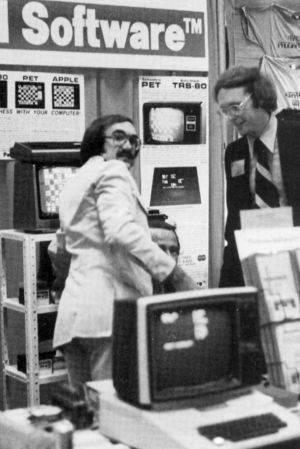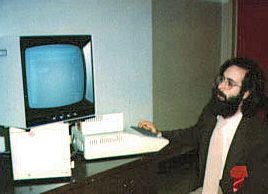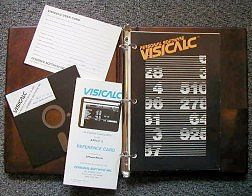VisiCalc 1979
 In May, we had a booth at the West Coast Computer Faire in San Francisco. The WCCF coincided with our move from
Boston to California. We were operating out of our new offices, but there was no furniture. It also coincided with
the gasoline shortage which created mammoth lines at the pumps. We took the train from Palo Alto to San Francicso
for the show.
In May, we had a booth at the West Coast Computer Faire in San Francisco. The WCCF coincided with our move from
Boston to California. We were operating out of our new offices, but there was no furniture. It also coincided with
the gasoline shortage which created mammoth lines at the pumps. We took the train from Palo Alto to San Francicso
for the show.

We rented a special room to secretly demonstrate VisiCalc to key industry luminaries. Steve Jobs, Steve Wozniak, Adam Osborne, Ted Nelson, Vern Raburn, Ben Rosen, Portia Isaacson, Chuck Peddle and many others were treated to early demonstrations by Dan Bricklin, Dan Fylstra or myself. After each demonstration we tried to pick their brains for marketing advice. The key question was what should we charge. The range of suggestions was $25 to $400 a copy, with most of the suggestions at the low end of the range.
That summer, Personal Software was permanently installed on Weddell Drive in Sunnyvale. We placed teaser ads in Byte Magazine. VisiCalc, How did you ever do without it? We also decided on a packaging solution that would be practical and inexpensive to produce, yet would inspire confidence and offer a business-like appearance in contrast to our existing line of game products, packaged in greeting card boxes with clear plastic lids. We settled on the brown binders with gold embossed printing which were readily available and represented a giant step up in quality from the other products on the shelves in the computer stores.
It was only a few months after we shipped that almost all business software from any vendor came packaged in
identical brown binders. This same experience would be repeated a few years later when we moved
to box packaging with professional graphics.

Today, one might wonder why it took almost a year to bring out the VisiCalc product. First, Bob and Dan in Boston were working night and day to perfect the software and optimize it for maximum performance on an Apple ][ with 32 to 48K of memory. (I don't think it ran on the 16K models). Meanwhile, Dan and I in Sunnyvale were doing our best to create a professional product with documentation to match the software quality. We hired a professional writer to write the manual (which we paid for, rejected and rewrote), printed it on high quality glossy stock, and enclosed a well conceived and useful reference card. This professional approach to software for personal computers was unique at the time.
I remember clearly a day in August when Dan Fylstra and I were exploring various business plans. VisiCalc was almost ready for shipment. As we generated spreadsheet after spreadsheet and manipulated the many variables inherent in different strategies, we realized with clarity the power of the tool we had at our disposal. We could change assumptions, change costs, change formulae and instantly see the effect it would have on profitability and cash flow. We realized that startup companies everywhere were doing the same thing without VisiCalc to help them. Simultaneously we asked the rhetorical question, “Should we keep this advantage to ourselves?”. Of course not, but it was an interesting thought and a clear example of the power VisiCalc would grant to analysts and planners everywhere.
It is especially noteworthy that both Dan and I had often written quick disposable programs in the handiest available language to do this kind of analysis before. Four years earlier, I had made a living selling financial planning software on a timesharing system, and advocating the use of APL to perform exactly the functions done visually by VisiCalc for us on that day. I was very glad I had left Comshare to pursue the personal computer industry opportunity. We understood the power of the spreadsheet.
On the very day that VisiCalc first shipped to customers, I sat at my desk and pondered what was missing in VisiCalc. By now, I had created more VisiCalc spreadsheets than any user except Bob and Dan. Many of the features and changes I had suggested along the way had been incorporated. Other ideas were too complicated or too late for the first version. I filled a blank sheet of paper with the requirements for VisiCalc II. When Mitch Kapor released Lotus 1-2-3 in January 1983, many of the items on that list were incorporated in his product. They were not yet in VisiCalc and that was a major factor in Lotus’ success and VisiCorp’s demise as well as an issue leading to the later litigation between Software Arts and VisiCorp.
